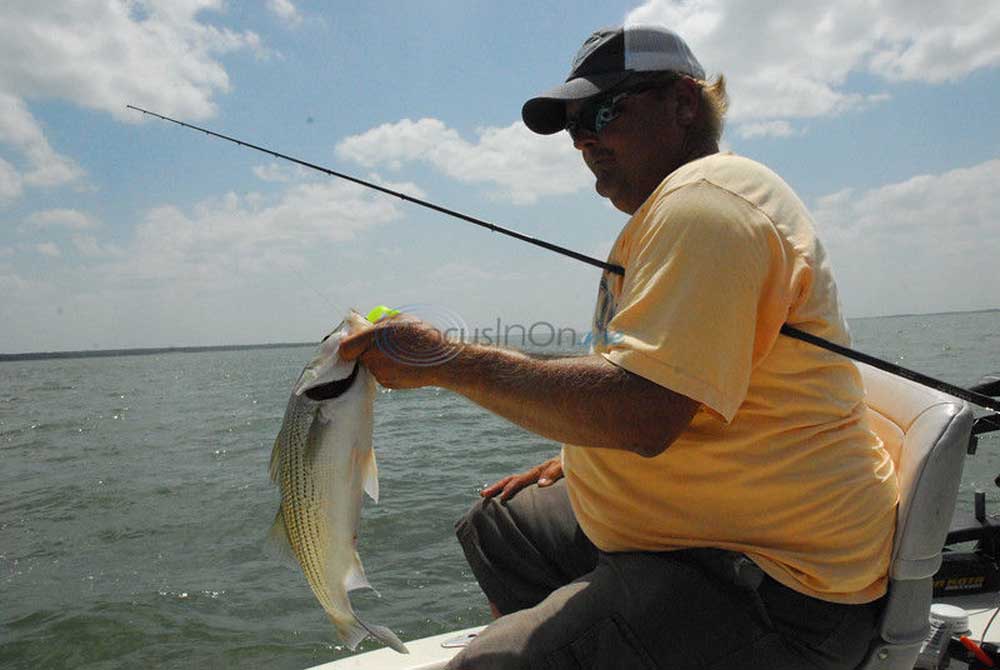When The Fish Don’t Bite, A Backup Plan Helps
Published 9:52 pm Saturday, June 15, 2013

- Steve Knight/Staff Hybrid striped bass on cooper lake have not moved into a summer pattern causing fishermen to be creative.
COOPER — Not every day on the water fishing is a perfect day.
That is why it is always good to have a plan B and maybe a C or D.
Trending
When it comes to just catching fish, Cooper Lake has become my go-to reservoir. Only an hour and a half drive from Tyler, the lake is among the best in Northeast Texas when it comes to hybrid striped bass and white bass.
Like a lot of lakes that are in the rotation with the put-and-take hybrid fishery, stocking has been hit and miss in recent years as golden algae and strange weather have plagued production of the striped bass/white bass cross. It has impacted the quality of the fishery over the years, but not as much as some other lakes because of the lack of fishing pressure.
Last week seemed like a good time to head back to the lake. The weather has been getting warmer, but not like it will in the coming weeks. Still the fish by this time of year are in a summer pattern. OK, should be in a normal summer pattern, but this isn’t a normal year.
With early spring weather in the winter that turned into late winter weather in the spring fishing has been a half-step off for months.
“They are running about a month behind,” warned guide Tony Parker. “The water right now is just 81 degrees.”
That isn’t Parker’s biggest concern right now on the lake. With a long summer ahead, water temperatures are certain to climb to near-boiling and the bass will be where they belong. With mud churning from the boat prop as he backed away from the ramp, the guide said he is more worried about the lake level. Already down eight feet it is bound to drop more unless a hurricane moves onshore in the coming weeks.
Trending
Instead of the fish being bunched like they should be on the 19,000-acre lake straddling the South Sulphur River, they were scattered around the humps and flats. The one time Parker’s big Lowrance side scan fish finder showed wads of fish in 20 feet of water we couldn’t entice them to hit.
We started with Parker’s standard four-inch chartreuse Sassy Shad on a half-ounce weight. Drifting with the wind we would cast, let the bait fall to the bottom, pull it up about 10 winds and let it fall again. The baits can attract either hybrids or white bass, but because of its size it is more likely to be a hybrid that takes it.
I think I missed the first four or five fish that bumped the lure. They were probably white bass chasing the tail.
“You can’t set the hook,” Parker admonished me. “You have to keep reeling.”
It was a hard habit to break, but a necessary one I finally picked up on after several more swings and misses.
We picked up maybe a dozen hybrids, most in the 3- to 5-pound range but still good fighters. Parker explained this has been a good year for big fish on the lake. He credits that primarily on maturity of earlier stocking classes. However, while he has had 28 fish over 10 pounds in his boat this year, the summer months aren’t big fish months for hybrids.
While we were fishing Parker was constantly looking for nervous water, bait fish pushed to the surface by the hybrids and whites. Even better would be an acre of the game fish on the surface attacking the shad. It should have happened, but never did. In all we may have seen four hybrids on the top, and all were individual fish.
Even odder was one area near the dam that was full of shad breaking the surface and swimming just below, but without a white bass or hybrid in sight.
It was about then Parker went to plans B and C. Again the graph was showing plenty of fish on the bottom, but not up actively feeding, so he went to jigging spoons, one cast and worked back to the boat, and the other fished vertically off the side of the boat. They were white bass magnets.
If the water level stays up a summer pattern should develop soon on the lake. With about 175,000 fingerlings stocked this spring, the fishery should continue do well.
Closer to home, Lake Palestine has also been stocked this year with 200,000 hybrid fingerlings and 451,000 fry. Forget the fry, however. Their chances of survival are somewhere between slim and none.
Other area lakes receiving hybrids are Cedar Creek, Richland-Chambers and Tawakoni.
For more information on fishing Cooper, contact Parker at 903-348-1619 or tawakonifishing-
@yahoo.com.
Have a comment or opinion on this story? Contact outdoor writer Steve Knight by email at outdoor@tylerpaper.com. Follow Steve Knight on Facebook at TylerPaper Outdoors and on Twitter @tyleroutdoor.






